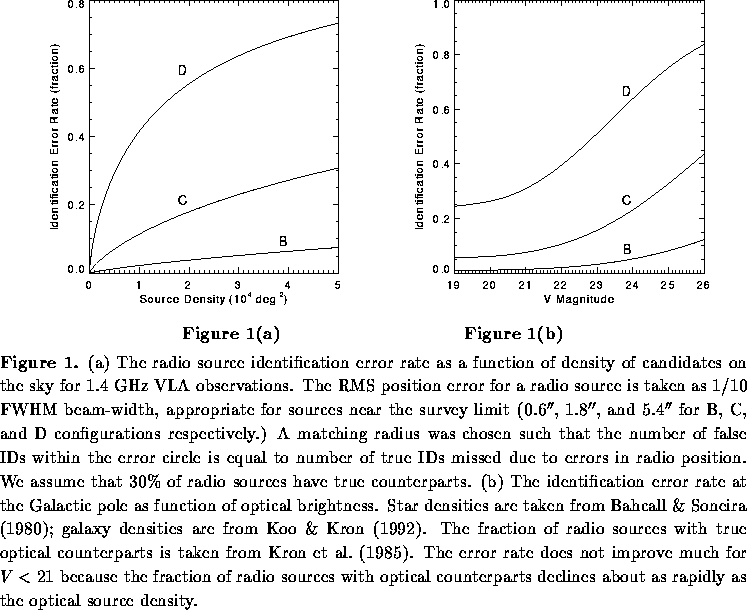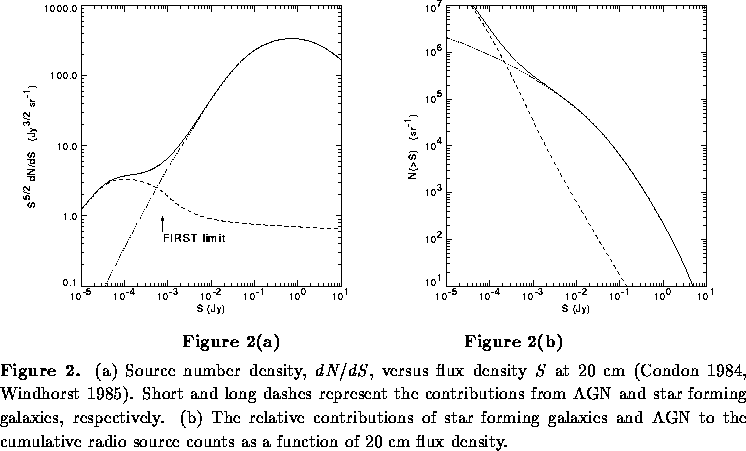The primary desiderata for the design of the FIRST survey were:
We discuss each of these issues briefly here.
While considerable information on the source type and radiation
mechanism of a radio emitter can be derived from observations of its
radio morphology, spectrum, and polarization characteristics, optical
observations are still required to establish the source's distance and
to classify it unambiguously. Given the faint magnitudes of optical
counterparts to radio sources at the mJy level - a
identification rate is only achieved at
(Kron, Koo, and
Windhorst 1985) - and the high surface density of optical objects on
the sky at these magnitudes (
), accurate radio
positions are required to obtain high reliability identifications with
a low rate of chance coincidences. Figure 1 displays the false
identification rate as a function of optical source density which led
to the choice of the
-configuration for the FIRST survey. At
the POSS I limit of
, 50%of the sky has a surface density
in stars and galaxies of
, producing a 25%false
rate for the D-configuration survey. At the SDSS limit of
, the entire FIRST survey region has a density
objects
, and the maximum surface density encountered
is
. This leads to a C-configuration false rate of
and a D-configuration false rate of
, but leaves the
B-configuration rate at less than 8%. In addition, the fact that 55%of sources which will appear point-like in the D-configuration are, in
fact, extended and/or multiple sources (see § 7.3) leads to an additional
uncertainty in their positions and increased difficulty in finding
optical counterparts. In § 7.1, we show that we have achieved the
theoretical positional accuracy of
using the
B-configuration. In a subsequent paper, we demonstrate the practical
implementation of an optical identification program for FIRST
using the Cambridge/Institute of Astronomy APM scans of the POSS I
plates (McMahon et al. 1995).

Figure 2a presents the curve for radio sources
observed at 20 cm (Condon 1984). At flux densities
mJy, the
radio population is dominated by active galactic nuclei (AGN) including
radio galaxies, BL Lac objects, and radio-loud quasars. Below 3 mJy,
however, the
curve flattens substantially, indicating the
presence of a new population. Several authors (Windhorst et al. 1985;
Oort 1987; and Thuan and Condon 1987) have
identified this new component with moderate redshift star-forming
galaxies. In Figure 2b, we show the expected contributions of these
two principal source classes as a function of limiting flux density (Condon
1984). At the FIRST threshold, we will detect
AGN and
over 250,000 star-forming galaxies. § 9 lists some of the
scientific advances we can expect with such massive samples in hand.

Radio sources exhibit a wide range of morphological types which provide clues
to the source class, emission mechanism, and properties of the surrounding
medium. Among high Galactic latitude sources, stars, radio pulsars, and
many AGN such as BL Lac objects, OVV quasars, and, in general, flat and
inverted spectrum sources, are point-like at a resolution of a few arcseconds.
Other AGN, from nearby low-power radio galaxies to distant quasars, display
jets, halos, and large-scale radio lobes. When these objects are found in
dense cluster environments, the lobes are often distorted by the motion of the
parent galaxy through the intracluster medium, producing head-tail sources
(Owen et al. 1979). Distant sources may be distorted into arcs of emission by
gravitational focusing from foreground clusters (Soucail 1991).
The thermal emission detected from
star-forming galaxies may be highly concentrated in a nuclear starburst, or
spread more generally throughout the galactic disk. Finally, the physical
clustering of sources in galaxy groups, clusters, and larger scale structures
can present a source confusion problem more severe than that determined from
consideration of the alone. For the final adopted parameters
of the FIRST survey, we reach a source surface density of
sources
with
resolution elements
,
a factor of 100 removed from the confusion limit.
The high angular resolution which allows detailed morphological studies, our optical-quality astrometry, and FIRST's faint flux density threshold has a concomitant price: some of the flux from extended sources will be resolved out, leading to 1) a survey threshold that is a function of source size, and 2) the systematic underestimate of extended source flux densities. The magnitude of these effects depends on the intrinsic size distribution for the sources of interest. Windhorst et al. (1990) have examined the size distribution of faint radio sources by collecting data from all of the major 1.4 GHz surveys, and deriving expressions for the mean angular size as a function of flux density, as well as the integral angular size distribution function. They find
where is the fraction of sources larger than angular size
, and
the median angular size
at flux density
is given by
where is measured in mJy at 1.4 GHz.
As shown in § 7, the fraction of the flux density from a Gaussian source
resolved out by the B configuration is only 3%at FWHM, 16%at
, and 23%at
.
However, CLEAN bias (also discussed in § 7) is a
larger problem for extended sources, and must be included in a calculation of
the fraction of sources that will be missing from any FIRST catalog as a
result of resolution effects. In Table 1, we tabulate the values of
,
, and
for flux density levels ranging from 30 mJy (the limit
of the best existing centimetric catalog) to 1 mJy;
is the
angular size at which, owing to CLEAN bias and resolution effects, a source
falls below our search algorithm's peak flux density threshold of 0.75 mJy.
These estimates suggest we will miss of sources with integrated flux
densities between 5 and 50 mJy, and one third of all sources between 1 and
5 mJy. However, this estimate is too pessimistic for several reasons. First,
using a peak-flux search algorithm to find extended sources on maps optimized
for point source sensitivity (e.g., made using natural weighting) is far from
the optimal strategy for finding extended objects; indeed, as we show in
§ 7.2, a much larger fraction of faint sources actually appear in our maps.
Secondly, the numbers in the table have been calculated from experiments which
insert Gaussian sources of various sizes into our raw UV data and
then determine what fraction of the true flux density is recovered
in the maps.
Real extended objects, however, often have bright, compact features which will
raise the peak flux density in the map above our threshold.
The VLA A-configuration observations of the Westerbork LBDS sources
(Oort et al. 1987; Oort 1988) demonstrate this latter effect. A total
of 145 sources with integrated flux densities mJy at 20 cm
as detected with the
Westerbork beam were observed at
the VLA; 14 of the larger objects were resolved into multiple
components. After accounting for CLEAN bias and resolution effects, and
imposing a 0.75 mJy peak flux density threshold, we would detect all
but 20 of the 166 components. We would miss
of those
between 1 and 2 mJy,
of sources from 2 to 5 mJy, and only 1
of the 82 sources brighter than 5 mJy. This is consistent with the
comparison of our images with a VLA deep survey of the same region
which we present in § 7.2.